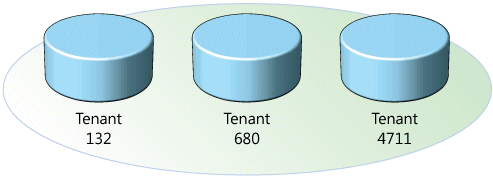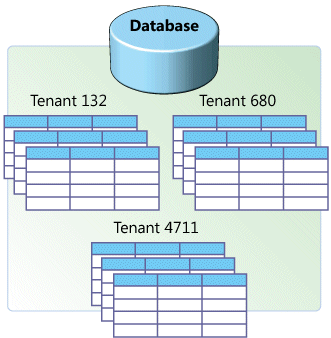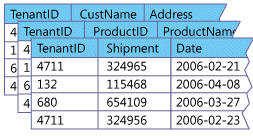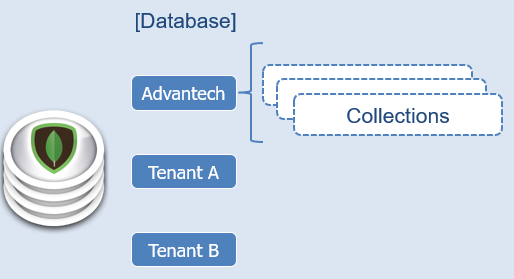WISE-PaaS/Multi-tenant
Contents
Introduction
Trust, or the lack thereof, is the number one factor blocking the adoption of software as a service (SaaS). A case could be made that data is the most important asset of any business—data about products, customers, employees, suppliers, and more. And data, of course, is at the heart of SaaS. SaaS applications provide customers with centralized, network-based access to data with less overhead than is possible when using a locally-installed application. But in order to take advantage of the benefits of SaaS, an organization must surrender a level of control over its own data, trusting the SaaS vendor to keep it safe and away from prying eyes.
To earn this trust, one of the highest priorities for a prospective SaaS architect is creating a SaaS data architecture that is both robust and secure enough to satisfy tenants or clients who are concerned about surrendering control of vital business data to a third party, while also being efficient and cost-effective to administer and maintain.
This is the second article in our series about designing multi-tenant applications. The first article, Architecture Strategies for Catching the Long Tail, introduced the SaaS model at a high level and discussed its challenges and benefits. It is available on MSDN. Other articles in the series will focus on topics such as workflow and user interface design, overall security, and others.
In this article, we'll look at the continuum between isolated data and shared data, and identify three distinct approaches for creating data architectures that fall at different places along the continuum. Next, we'll explore some of the technical and business factors to consider when deciding which approach to use. Finally, we'll present design patterns for ensuring security, creating an extensible data model, and scaling the data infrastructure.
Three Approaches to Managing Multi-Tenant Data
The distinction between shared data and isolated data isn't binary. Instead, it's more of a continuum, with many variations that are possible between the two extremes.
Data architecture is an area in which the optimal degree of isolation for a SaaS application can vary significantly depending on technical and business considerations. Experienced data architects are used to considering a broad spectrum of choices when designing an architecture to meet a specific set of challenges, and SaaS is certainly no exception. We shall examine three broad approaches, each of which lies at a different location in the continuum between isolation and sharing.
- Separate Database
Storing tenant data in separate databases is the simplest approach to data isolation.
Computing resources and application code are generally shared between all the tenants on a server, but each tenant has its own set of data that remains logically isolated from data that belongs to all other tenants. Metadata associates each database with the correct tenant, and database security prevents any tenant from accidentally or maliciously accessing other tenants' data.
Giving each tenant its own database makes it easy to extend the application's data model (discussed later) to meet tenants' individual needs, and restoring a tenant's data from backups in the event of a failure is a relatively simple procedure. Unfortunately, this approach tends to lead to higher costs for maintaining equipment and backing up tenant data. Hardware costs are also higher than they are under alternative approaches, as the number of tenants that can be housed on a given database server is limited by the number of databases that the server can support. (Using autoclose to unload databases from memory when there are no active connections can make an application more scalable by increasing the number of databases each server can support.)
Separating tenant data into individual databases is the "premium" approach, and the relatively high hardware and maintenance requirements and costs make it appropriate for customers that are willing to pay extra for added security and customizability. For example, customers in fields such as banking or medical records management often have very strong data isolation requirements, and may not even consider an application that does not supply each tenant with its own individual database.
- Share Database, Separate Scheme
Another approach involves housing multiple tenants in the same database, with each tenant having its own set of tables that are grouped into a schema created specifically for the tenant.
Like the isolated approach, the separate-schema approach is relatively easy to implement, and tenants can extend the data model as easily as with the separate-database approach. (Tables are created from a standard default set, but once they are created they no longer need to conform to the default set, and tenants may add or modify columns and even tables as desired.) This approach offers a moderate degree of logical data isolation for security-conscious tenants, though not as much as a completely isolated system would, and can support a larger number of tenants per database server.
A significant drawback of the separate-schema approach is that tenant data is harder to restore in the event of a failure. If each tenant has its own database, restoring a single tenant's data means simply restoring the database from the most recent backup. With a separate-schema application, restoring the entire database would mean overwriting the data of every tenant on the same database with backup data, regardless of whether each one has experienced any loss or not. Therefore, to restore a single customer's data, the database administrator may have to restore the database to a temporary server, and then import the customer's tables into the production server—a complicated and potentially time-consuming task.
The separate schema approach is appropriate for applications that use a relatively small number of database tables, on the order of about 100 tables per tenant or fewer. This approach can typically accommodate more tenants per server than the separate-database approach can, so you can offer the application at a lower cost, as long as your customers will accept having their data co-located with that of other tenants.
- Share Database, Share Scheme
A third approach involves using the same database and the same set of tables to host multiple tenants' data. A given table can include records from multiple tenants stored in any order; a Tenant ID column associates every record with the appropriate tenant.
Of the three approaches explained here, the shared schema approach has the lowest hardware and backup costs, because it allows you to serve the largest number of tenants per database server. However, because multiple tenants share the same database tables, this approach may incur additional development effort in the area of security, to ensure that tenants can never access other tenants' data, even in the event of unexpected bugs or attacks.
The procedure for restoring data for a tenant is similar to that for the shared-schema approach, with the additional complication that individual rows in the production database must be deleted and then reinserted from the temporary database. If there are a very large number of rows in the affected tables, this can cause performance to suffer noticeably for all the tenants that the database serves.
The shared-schema approach is appropriate when it is important that the application be capable of serving a large number of tenants with a small number of servers, and prospective customers are willing to surrender data isolation in exchange for the lower costs that this approach makes possible.
WISE-PaaS Platform Database Multi-tenant
Phase I (Single Instance)
- PostgreSQL (Share Database, Separate Scheme)
- Mongodb (Separate Database)






